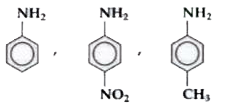Arrange the following in increasing order of their basic strength:
(i) C2H5NH2,C6H5NH2,NH3,C6H5CH2NH2and(C2H5)2NH
(ii) C2H5NH2,(C2H5)NH,(C2H5)3N,C6H5NH2
(iii) CH3NH2,(CH3)2NH,(CH3)3N,C6H5CH2NH2.
(i) C6H5NH2, N is directly linked to the benzene ring and hence the lone pair of electrons on the N-atom is delocalized over the benzene ring. In contrast, N in C6H5CH2NH2 is not directly linked to the benzene ring and hence its lone pair is not delocalized over the benzene ring. in other words, the lone pair of electrons on the N-atom in C6H5CH2NH2 is more easily available for protonation than that on the N-atom in C6H5NH2. thus, C6H5CH2NH2 is more basic than C6H5NH2. Now due to -I-effect of the C6H5 group, electron density on the N-atom in C6H5CH2NH2 is lower than that on the N-atom in C2H5NH2, therefore, C2H5NH2 is more basic than C6H5CH2NH2. Lowerver, both the them are stronger bases than NH3. further due to +I-effect of the two C2H5 C2H5 groups in (C2H5)2NH as compared to one in C2H5NH2,(C2H5)2NH is a stronger base than C2H5NH2. thus, the overall basic strength increases in the order:
C6H5NH2<NH3<C6H5CH2NH2<C2H5NH2<(C2H5)2NH
(ii) In C2H5NH2,(C2H5)2NHand(C2H5)3N, the +I-effect of the C2H5 group/s increases the electron density on the N-atom. however, in C6H5NH2, the electron density on the N-atom decreases due to delocalization of the lone pair of electrons over the benzene ring. therefore, all the three ethylamines are more basic than C6H5NH2.
The relative basic strength of C2H5NH2,(C2H5)2NHand(C2H5)3N depends upon the stabilization of their corresponding conjugate acids (formed as a result of accepting a proton from water) by a number of factors such as H-bonding, steric hindrance of the alkyl groups and +I-effect of the alkyl groups. All of factors such as H-bonding, steric hindrance of the alkyl groups and +I-effect of the alkyl groups. all these factors are favourable for 2∘ amines, therefore, (C2H5)2NH is a stronger base than C2H5NH2and(C2H5)3N. since C2H5 group is bigger, it exerts some steric hindrance to H-bonding. therefore, stabilization of the conjugate acid derived from (C2H5)3N due to +I-effect is greater than the stabilization of the conjugate acid derived from C2H5NH2 by H-bonding i.e.,

Therefore, (C2H5)3N is more basic than C2H5NH2. The overall basic strength of the four amines increases in the order: C6H5NH2<C2H5NH2<(C2H5)3<(C2H5)2NH
(iii) As explained in answer (i) above, C6H5CH2NH2 is more basic than C6H5NH2. now due to +I-effect of the CH3 groups , th electron density on the N-atom in CH3NH2,(CH3)2NHand(CH3)3N increases. however, in C6H5NH2andC6H5CH2NH2 electron density on the N-atom decreases due to electron-withdrawig resonance effect (i.e., -R-effect) of the C6H5 group in C6H5CH2NH2. therefore, all the three methylamines are more basic than C6H5NH2andC6H5CH2NH2.
now, the relative basic strength of CH3NH2,(CH3)2NH and (CH3)3N depends upon the stabilization of their conjugate acids (formed as a result of accepting a proton from H2O) by a number of factors such as H-bonding, steric hindrance of the alkyl groups and -I-effect of the alkyl groups. all these such as H-bonding, steric hindrance of the alkyl groups and +I-effect of the alkyl groups. all these factors are favourable for 2∘ amines, therefore, (CH3)2NH is a stronger base than CH3NH2and(CH3)3N. since CH3 group is the smallest, it does not exert any steric hindrance. therefore, stabilization of the conjugate acid derived from CH3NH2 due to H-bonding is greater than that of the conjugate acid derived from (CH3)3N due to +I-effect of the three CH3 groups, i.e.,
 .
.
Therefore, CH3NH2 is a stronger base than (CH3)3N. thus, the overall basic strength of the five amines increases in the order:
C6H5NH2<C6H5CH2NH2<(CH3)3N<CH3NH2<(CH3)2NH.
Topper's Solved these Questions
- ORGANIC COMPOUNDS CONTAINING NITROGENBOOK - PRADEEPCHAPTER - ORGANIC COMPOUNDS CONTAINING NITROGENEXERCISE - NCERT QUESTIONS AND EXERCISES WITH ANSWERS (NCERT EXERCISES)
14 Videos
- ORGANIC COMPOUNDS CONTAINING NITROGENBOOK - PRADEEPCHAPTER - ORGANIC COMPOUNDS CONTAINING NITROGENEXERCISE - NCERT EXEMPLANAR PROBLEMS WITH ANSWERS, HINTS AND SOLUTIONS (MUTIPLE CHOICE QUESTIONS-I)
27 Videos
- ORGANIC COMPOUNDS CONTAINING NITROGENBOOK - PRADEEPCHAPTER - ORGANIC COMPOUNDS CONTAINING NITROGENEXERCISE - NCERT QUESTIONS AND EXERCISES WITH ANSWERS (NCERT INTEX SOLVED QUESTIONS)
5 Videos
- HALOALKANES AND HALOARENESBOOK - PRADEEPCHAPTER - HALOALKANES AND HALOARENESEXERCISE - IMPORTANT QUESTIONS FOR BOARD EXAMINATION
22 Videos
- P-BLOCK ELEMENTS BOOK - PRADEEPCHAPTER - P-BLOCK ELEMENTS EXERCISE - IMPORTANT QUESTIONS FOR BOARD EXAMINATION
25 Videos
Similar Questions
Arrange the following in increasing order of their basic strength:
(i) C2H5NH2,C6H5NH2,NH3,C6H5CH2NH2and(C2H5)2NH
(ii) C2H5NH2,(C2H5)NH,(C2H5)3N,C6H5NH2
(iii) CH3NH2,(CH3)2NH,(CH3)3N,C6H5CH2NH2.
View SolutionArrange the following in increasing order of their basic strength :
(i) C2H5NH2,C6H5NH2,NH3,C6H5CH2NH2 and (C2H5)2NH (ii) C2H5NH2,(C2H5)2NH,(C2H5)3N,C6H5NH2
(iii) CH3NH2,(CH3)2NH,(CH3)3N,C6H5NH2,C6H5CH2NH2
View SolutionArrange the following in increasing order of their basic strength :
(i) C2H5NH2,C6H5NH2,NH3,C6H5CH2NH2 and (C2H5)2NH.
(ii) C2H5NH2,(C2H5)2NH,(C2H5)3N,C6H5NH2.
(iii) CH3NH2,(CH3)2NH,(CH3)3N,C6H5NH2,C6H5NH2.
View SolutionArrange the following in increasing order of their basic strength :
(i)C2H5NH2,C6H5NH2,C6H5CH2NH2 and (C2H5)2NH
(ii) C2H5NH2,(C2H5)2NH,(C2H5)3N,C6H5NH2
(iii) CH3NH2,(CH3)2NH,(CH3)3N,C6H5NH2,C6H5CH2NH2
View SolutionArrange the following in increasing order basic strength :
(i) C6H5−NH2,C6H5CH2−NH2,C6H5NH−CH3
(ii)
View SolutionArrange the following in decreasing order of their basic strength :
C6H5NH2,C2H5NH2,(C2H5)2NH3
View SolutionRerrange the following in an increasing order of their basic strengths:
C6H5NH2,C6H5N(CH3)2,(C6H5)2 NH and CH3NH2.
View SolutionRearrange the following in an increasing order of their basic strenghts :
C6H5NH2,C6H5N(CH3)2,(C6H5)2NHandCH3NH2
View SolutionArrange the following in decreasing order of their basic strength :
C6H5NH2,C2H5NH2,(C2H5)2NH3
View SolutionRearrange the following in an increasing order of their basic strenghts :
C6H5NH2,C6H5N(CH3)2,(C6H5)2NHandCH3NH2
View Solution
